Kambo (drug)
Kambo, also known as vacina-do-sapo, or sapo (from Portuguese "sapo", lit. meaning "toad"), is the dried skin secretions of the kambô, a species of frog, used as a transdermal medicine. No scientific evidence supports its effectiveness.
| Kambo (drug) | |
|---|---|
 A kambo ceremony: the frog secretion is being applied to the burnt skin | |
| Alternative therapy | |
| Claims | It is claimed that kambo will help with a number of issues including, depression, anxiety, addiction, fertility, fever, mental clarity, negative energy and the cleansing of the body |
Kambo is usually used in a group setting, called a Kambo circle or Kambo ceremony. The effects on humans usually include tachycardia, nausea, vomiting, and diarrhea, however, a meta-review of 50 studies in which 11 cases of acute intoxication were examined found that extreme cases may include psychosis (occasionally severe), SIADH, kidney damage (including acute renal failure), pancreas damage, liver damage including toxic hepatitis, dermatomyositis, esophageal rupture, seizures, and death, although evidence for these is limited.[1][2][3]
Kambo, which originated as a folk medicine practice among the Amazon indigenous peoples, is also administered as an alternative medicine treatment in the West, often as a pseudoscientific cleanse or detox. The ceremony involves burning an arm or leg and applying the kambo secretion directly to the burn. Promoters claim that kambo helps with several illnesses or injuries, but there is no scientific evidence that it is an effective treatment.[4][5][6][lower-alpha 1]
It seems to be particularly dangerous to take a kambo with large quantities of water. Doing that is associated with SIADH and severe electrolyte imbalances: changes in plasma and urine osmolarity, hypokalemia, hypomagnesemia and hypophosphatemia. Naloxone is under study as a possible antidote; hospital treatment also includes medicines to protect organs from damage and restore electrolyte function.[7]
Common terms
- Kampo pae, name used by the Noke Kuin (formerly Katukina)[8]
- Dow kiet, a word used by the Matses[9]
- Sapo, kampô, kampu, vacina de sapo or vacina da floresta, in Brazilian Portuguese[10]
"Kambô" is a common name of Phyllomedusa bicolor, an Amazonian tree frog, also known as the blue-and-yellow frog, bicolored tree-frog, giant monkey frog, giant leaf frog, or waxy-monkey tree frog. "Sapo" means "toad" in Spanish and Portuguese.[1] The frog is an anuran amphibian that inhabits the Amazon and Orinoco basins in South America.[11]
History
Natives who practice kambo are Panoan-speaking indigenous groups in the southeast Amazon rainforest, such as the Mayoruna, Matses, Marubo, Amahuaca, Kashinawa, Katukina, Yawanawá, and the Kaxinawá.[2][12][4] There are ethnographic studies on the use of kambo in traditional Noke Kuin medicine in the region of the state of Acre, in the Brazilian Amazon.[13]
Since the mid-20th-century, kambo has also been practiced in urban regions of Brazil.[14][12] In 2004, Brazil banned the sale and marketing of kambo.[15] Import is illegal in Chile.[16] Outside of South America, it first became known as an alternative therapy in the late 2010s.[17]
In 2021 the Therapeutic Goods Administration of Australia (TGA) banned the use of Kambo in Australia and classified it as a schedule 10 poison. It is listed in the category for “substances of such danger to health as to warrant prohibition of sale, supply and use”.[5][lower-alpha 1]
Indigenous use
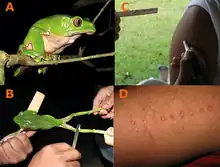
To collect the secretions from the frog's body, first, the frog has to be caught. A practitioner will tie the frog to four sticks placed in the ground with its limbs completely stretched. The pulling causes the frog to become stressed enough to activate its defense mechanism and secrete a substance containing peptides from its skin.[18] After obtaining secretions, the frog goes back into the wild. The secretions are then left to dry.[18] Small burns are created on the skin, and a small dose of the frog secretions applied to the open wounds.[18] In native practice, the secretions are removed from the wounds after 15 to 20 minutes, ending the acute symptoms.[4]
Traditional practitioners claim that it aids fertility, cleanses the body and soul, increases strength, and brings good luck to hunts, though there is no evidence for these claims.[14][19] It is used by natives to who attempt to expel "panema" (bad spirit) and to induce abortions.[4] The secretions are also commonly used in people who suffer from tikish or laziness, a condition perceived as unfavorable by the Noke Kuin as the person stops participating socially.[20]
Joaquim Luz, a Yamanawa leader, criticized commercial sales and kambo's use without the preparation or permission of indigenous peoples, saying that the toxin users are at risk of death.[15] Other native groups have also expressed concerns.[14][12]
Non-indigenous use
Outside South America, a kambo ceremony can involve just two people, the practitioner, the participant, or many participants at once, which is known as a kambo circle. Participants are encouraged to bring plenty of water, a towel, and a bucket.[17] There are usually yoga mats on the floor and the ceremony room, which is often the practitioner's living room, is heavily incensed.[17]
During the ceremony, the participant's skin is deliberately burnt multiple times, usually on the upper arm or leg, by the practitioner using a smoldering stick or vine.[18] The practitioner uses saliva or water to reconstitute the frog secretions and place it on top of the burnt skin.[18] Participants may be encouraged to shout "Viva" whenever one of them vomits into their bucket.[21] Short-term effects include violent nausea, vomiting, diarrhea, edema (swelling) of the face, headaches, and tachycardia. The secretions seem to be vasoactive (affecting the circulation), explaining why they are absorbed rapidly.[4]
Intoxication may occur immediately or within hours.[7]
Medical claims
Non-indigenous users and practitioners of kambo claim that the alternative medicine helps with a wide variety of issues and conditions. These claims include treating addiction, depression, and chronic pain,[17][21][22] reducing fevers,[17] increasing fertility,[17] boosting energy and physical strength,[19][21] and improving mental clarity.[21] It is also claimed that kambo removes negative energy.[17][19] The causal role of kambo in positive outcomes is not proven.[23]
There is no solid medical evidence on how the frog toxins work, whether they are useful for treating anything, and whether they can be used safely: no clinical trials have tested them on humans, as of November 2019.[4] Reports of adverse effects are numerous, including for use with experienced guidance.[4]
Kym Jenkins of the Royal Australian and New Zealand College of Psychiatrists, in a Sydney Morning Herald article, said "people with mental illness are a more vulnerable group anyway for a variety of reasons. If you're feeling very anxious or very depressed ... you're automatically more vulnerable and you could be more susceptible to people advertising or marketing a quick fix. I do have concerns that people can be preyed upon when they are more vulnerable."[24].
There is currently no scientific evidence to support positive health effect claims.[4][5][lower-alpha 1]. However, most of the bioactive peptides so far characterized have displayed potential applications in medicine, such as phyllocaeruleins with hypotensive properties, tachykinins and phyllokinins as vasodilators, dermorphins and deltorphins with opiate-like properties, and adenoregulins with antibiotic properties.[25]
In a clinical trial of a randomized, placebo-controlled study in postoperative pain, dermorphin administered via the intrathecal route was "impressively superior" over the placebo and the reference compound morphine."[26] Due to the numerous biological activities of these substances and the similarities with the amino acid sequences related to mammalian neuropeptides and hormones, many have aroused the interest from a medical and pharmacological perspective, such as in the production of new drugs.[25]
The Australian Medical Association supports the Australian Therapeutic Goods Administrations ban on the sale, supply, and use of kambo, saying it considers kambo to be a “significant health risk”.[5][lower-alpha 1]
Marketing
In non-indigenous use, the frog secretion is described and marketed as a "detox" treatment, cleanse,[18][27] purge,[17] and as a "vaccine", which is "good for everything".[28] Kambo has been marketed both as a "scientific" remedy, emphasizing the biochemistry, and as a "spiritual" remedy, emphasizing its indigenous origins.[12] Purging (deliberate vomiting) has been a popular treatment since the 1800s.[18] "Detox" has been described by Edzard Ernst, emeritus professor of complementary medicine, as a term for conventional medical treatments for addiction, which has been "hijacked by entrepreneurs, quacks, and charlatans to sell a bogus treatment."[29]
In Brazil, given the growth in the consumption of kambo in urban centers, there has been criticism by indigenous people, academics and communicators regarding the cultural appropriation of indigenous knowledge, the process of extracting the secretion of the Phyllomedusa bicolor frog, the form of transmission of wisdom, and the price charged by the ritual and the mystification of the origin of the frog.[12]
There is also concern about pharmacological patents on the peptides identified in kambo (see biopiracy), the commercialization of the kambo outside its place of origin, and the unknown impact on frog populations, since many more are now removed from their natural habitats.[28]
In light of the chemical complexity of the frog toxins, and their complex and potentially fatal effects, the authors of a 2022 review on the diagnosis and treatment of kambo cases said they urged "strict surveillance of the websites that encourage the use of this substance and [we] urge greater control of e-commerce or illicit trafficking of animals and secretions, including through the dark web".[7]
Environmental impact
The effect of the increased use of kambô rituals, and trafficking of the frogs and their secretions, may have an effect on the population of Phyllomedusa bicolor in its natural habitats: the forests of Bolivia, Peru, Brazil, the Guianas, Colombia, and Venezuela.[14] Phyllomedusa bicolor is not considered an endangered species by the IUCN.[30] Besides Phyllomedusa (species?), other threatened endemic frog species of South America's neotropical regions have been poached and smuggled on the black market.
- Species used
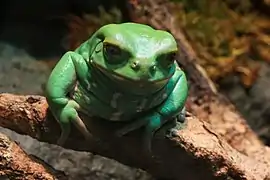 Phyllomedusa bicolor
Phyllomedusa bicolor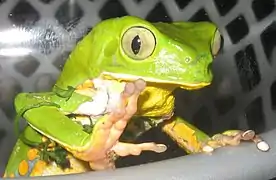 Tree frog, Caetité, Bahia, Brazil
Tree frog, Caetité, Bahia, Brazil Phyllomedusa hypochondrialis
Phyllomedusa hypochondrialis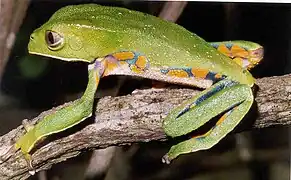 Phyllomedusa burmeisteri
Phyllomedusa burmeisteri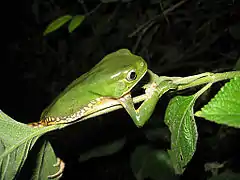 Phyllomedusa theringii
Phyllomedusa theringii Phyllomedusa trinitatis
Phyllomedusa trinitatis Phyllomedusa distincta
Phyllomedusa distincta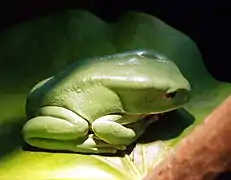 Bolivian Phyllomedusa
Bolivian Phyllomedusa Phyllomedusa azurea
Phyllomedusa azurea
Parasitology
Smuggling amphibians such as Phyllomedusa bicolor can spread parasites.[31] Zoos keep frogs for conservation purposes, and there are many parasites present in these animals that naturally occur only in the native habitats.[31] It is recommended for imported amphibians to go through a quarantine process to verify they are not spreading parasites that could damage other ecosystems.[31] Parasite infection rates in frogs is 51%, while in salamanders it is 13%.[31] Individuals who want to have them as pets are obligated and encouraged to get them examined to detect gastrointestinal parasites that could potentially be harmful.[31] Neocosmocercella fisherae is the first nematode species found parasitising Phyllomedusa bicolor from the Brazilian Amazon Region.[32]
Notable deaths
A 40-year-old businessman was charged in Brazil in 2008 with the illegal exercise of medicine and felony murder after administering kambo toxins to a business colleague, who died; the deceased's son, who said his father had pressured him into participating, suffered more minor effects.[33][14] In Chile in 2009, Daniel Lara Aguilar, who suffered from chronic lumbar disc disease, died immediately after taking kambo administered by a local shaman in a mass healing ceremony; the autopsy was inconclusive due to preexisting conditions.[15][34] The medical literature reported the 2018 case in Italy of a person with no known preexisting conditions besides obesity and ventricular hypertrophy, who, according to autopsy reports, died of cardiac arrhythmia while under the effects of kambo use.[35][14] In March 2019, kambo practitioner Natasha Lechner suffered a cardiac arrest and died while receiving kambo.[17][36][6] In April 2019, a homicide investigation was opened into the death by "severe cerebral edema" of a young person who had taken kambo toxins in Chile; the import of the frog and its secretions is illegal in Chile.[16][37] In October 2021, Australian man Jarred Antonovich died at a festival in New South Wales from a perforated oesophagus suspected to be caused by excessive vomiting after being administered kambo and n,n-dimethyltriptamine. After a car accident in 1997 from which he had to learn to walk and talk again, he was left with lasting impediments, the inquest heard, which may have contributed to the esophageal rupture.[38]
Pharmacology

The frog secretes a range of small chemical compounds of a type called peptides, which have several different effects.[39] Peptides found in the frog secretions include the opioid petides dermorphin and deltorphin, the vasodilator sauvagine, and dermaseptin, which exhibits antimicrobial properties in vitro.[4] Various other substances such as phyllomedusin, phyllokinin, caerulein, and adrenoregulin are also present.[39] There is active medical research into the peptides found in the skin secretions of Phyllomedusa bicolor, focusing on discovering their biological effects. There have been some preclinical trials in mice and rats, but no phase-1 tests or clinical trials of safety in humans, as of November 2019.[4]
See also
Notes
- Quoting from the direct statements below
[Australian] Therepeutic Goods Administration (TGA). "Consultation: Proposed amendments to the Poisons Standard - ACMS, ACCS and Joint ACMS/ACCS meetings, March 2021".
"Kambo use in the absence of medically trained supervision represents a significant health risk, especially for people with cardiovascular disease due to the significant cardiovascular effects.
Although rare, deaths have also been reported from kambo use.
The significant adverse effects from the topical application of kambo to scarified or burnt areas of skin include:
• nausea
• vomiting
• oesophageal rupture
• diarrhoea
• stomach pain
• liver damage
• burning sensation
• lowered blood pressure (hypotension)
• increased heart rate (tachycardia)
These effects are seen as part of the spiritual purification/healing process, however, there is no clinical evidence of kambo having any beneficial medical effect.
Onset of clinical signs and symptoms is rapid, and there have been reports of altered mental state, agitation, paranoia, delusions and general psychosis. There is insufficient information to characterise the risk from long-term repeated use of kambo."
Australian Medical Association (March 2021). "Australian Medical Association Submission to the Therapeutic Goods Administration – Proposed amendments to the Poisons Standard" (PDF). p. 3. Archived from the original (PDF) on 2021-10-06.
"The AMA supports the proposal to include a new Schedule 9 entry for Kambo. The AMA considers kambo to be a significant health risk for those who use it. In addition to its harmful effects both intended and adverse, the act of blistering the skin and applying kambo to the burnt area risks other health concerns such as infection. There is also a risk that using kambo would prevent a patient from seeing a medical practitioner for their medical condition and delay diagnosis.
Kambo should be regulated under the Poisons Standard as it appears to be used as a therapeutic product by ‘kambo practitioners’.[lower-alpha 2] There is currently insufficient evidence for its intended therapeutic effects."
References
- den Brave, Paul S; Bruins, Eugéne; Bronkhorst, Maarten W G A (2014). "Phyllomedusa bicolor skin secretion and the Kambô ritual". Journal of Venomous Animals and Toxins Including Tropical Diseases. 20 (1): 40. doi:10.1186/1678-9199-20-40. PMC 4582952. PMID 26413084.
- Daly, J. W.; Caceres, J.; Moni, R. W.; Gusovsky, F.; Moos, M.; Seamon, K. B.; Milton, K.; Myers, C. W. (1992). "Frog secretions and hunting magic in the upper Amazon: identification of a peptide that interacts with an adenosine receptor". Proceedings of the National Academy of Sciences. 89 (22): 10960–10963. Bibcode:1992PNAS...8910960D. doi:10.1073/pnas.89.22.10960. ISSN 0027-8424. PMC 50462. PMID 1438301.
- Byard, Roger W. (June 2020). "Is voluntary envenomation from the kambô ritual therapeutic or toxic?". Forensic Science, Medicine and Pathology. 16 (2): 205–206. doi:10.1007/s12024-019-00192-5. PMID 31630322. S2CID 204786581.
- Bartels, Emiel Jacob Henri; Dekker, Douwe; Amiche, Mohamed (26 November 2019). "Dermaseptins, Multifunctional Antimicrobial Peptides: A Review of Their Pharmacology, Effectivity, Mechanism of Action, and Possible Future Directions". Frontiers in Pharmacology. 10: 1421. doi:10.3389/fphar.2019.01421. PMC 6901996. PMID 31849670.
robust data on pharmacokinetics, efficacy and safety in humans are currently lacking
(this is not a reliable medical source; see talk tab) - Shepherd, Tory (6 October 2021). "Kambo, a lethal frog mucous used in shamanic rituals, banned by TGA after reports of deaths". The Guardian. Archived from the original on 7 October 2021. Retrieved 7 October 2021.
- Mackenzie, Bruce (4 May 2023). "Natasha Lechner not told about risk of death from Kambo frog poison vomiting ritual, inquest told". ABC News. Archived from the original on 4 May 2023. Retrieved 4 May 2023.
- Sacco, M. A.; Zibetti, A.; Bonetta, C. F.; Scalise, C.; Abenavoli, L.; Guarna, F.; Gratteri, S.; Ricci, P.; Aquila, I. (1 January 2022). "Kambo: Natural drug or potential toxic agent? A literature review of acute poisoning cases". Toxicology Reports. 9: 905–913. doi:10.1016/j.toxrep.2022.04.005. PMC 9061256. PMID 35515815.
The analysis of titles, abstracts and full texts led to the final selection of 11 cases of acute intoxication.
- Lima, Edilene Coffaci de (2000). Com os Olhos da Serpente: Homens, Animais e Espíritos nas Concepções Katukina sobre a Natureza (Thesis). p. 160. OCLC 55916126.
- Erspamer, Vittorio; Erspamer, Giuliana Falconieri; Severini, Cinzia; Potenza, Rosa Luisa; Barra, Donatella; Mignogna, Giuseppina; Bianchi, Antonio (September 1993). "Pharmacological studies of 'sapo' from the frog Phyllomedusa bicolor skin: A drug used by the Peruvian Matses Indians in shamanic hunting practices". Toxicon. 31 (9): 1099–1111. doi:10.1016/0041-0101(93)90125-3. PMID 8266343.
- Lima (2008): 170.
- "Phyllomedusa bicolor". AmphibiaWeb: Information on amphibian biology and conservation. [web application]. Berkeley, California: AmphibiaWeb. 2015. Retrieved 15 April 2016.
- Lima, Edilene Coffaci de; Labate, Beatriz Caiuby (15 October 2007). "'Remédio da Ciência' e 'Remédio da Alma': os usos da secreção do kambô (Phyllomedusa bicolor) nas cidades". CAMPOS - Revista de Antropologia Social. 8 (1). doi:10.5380/cam.v8i1.9553.
- De Lima, Edilene Coffaci (25 November 2014). "Cobras, xamãs e caçadores entre os Katukina (pano)". Tellus: 35–57. doi:10.20435/tellus.v0i15.161.
- Silva, Francisco Vaniclei Araújo da; Monteiro, Wuelton Marcelo; Bernarde, Paulo Sérgio (2019). ""Kambô" frog (Phyllomedusa bicolor): use in folk medicine and potential health risks". Revista da Sociedade Brasileira de Medicina Tropical. 52: e20180467. doi:10.1590/0037-8682-0467-2018. ISSN 1678-9849. PMID 30942261.
- Mundo, Leire Ventas (27 April 2016). "Kambó, el polémico veneno que se usa en Sudamérica como medicina para curarlo todo". BBC News Mundo (in Spanish).
- Vallejos, Ricardo Pérez. "San Felipe: joven mujer murió tras un ritual de sanación con veneno de rana". La Nación (in Spanish).
- Scherer, Jennifer (7 November 2019). "Australians Are Using This Amazonian Frog Poison Aa A Controversial Alternative Medicine". SBS. Archived from the original on 7 November 2019. Retrieved 15 December 2019.
- Van Zeller, Mariana; Brown, Jasmine; Effron, Lauren (29 March 2017). "This Amazonian tree frog's poison has become part of the latest supercleanse trend". ABC News. Archived from the original on 29 March 2017. Retrieved 15 December 2019.
- Schwarcz, Joe (29 September 2019). "The Right Chemistry: No evidence-based science supports kambo ritual". The Montreal Gazette. Archived from the original on 2 October 2019. Retrieved 16 December 2019.
- Lima, Edilene Coffaci de (2000). Com os Olhos da Serpente: Homens, Animais e Espíritos nas Concepções Katukina sobre a Natureza (Thesis). pp. 75–76. OCLC 55916126.
- Lavoipierre, Angela (7 September 2018). "Tree frog poison being used as an alternative medicine". ABC News. Archived from the original on 7 September 2018. Retrieved 15 December 2019.
- Duncan, Elly (22 November 2019). "South Australian Pair Banned Indefinitely From Providing Frog Poison Health Treatment 'Kambo'". SBS. Archived from the original on 22 November 2019. Retrieved 16 December 2019.
- Heiblig, Maël; Alcazer, Vincent; Plesa, Adriana; Labussière-Wallet, Hélène; Sujobert, Pierre (September 2021). "How to Transform an Exceptional Case Report Into a Therapy: Following the Frog Out of the Box". HemaSphere. 5 (9): e629. doi:10.1097/HS9.0000000000000629. ISSN 2572-9241. PMC 8354625. PMID 34386709.
- Hall, Bianca (17 May 2019). "Pedlars of new age cures are 'preying' on mentally ill, doctors warn". The Sydney Morning Herald. Archived from the original on 17 May 2019. Retrieved 16 December 2019.
- Nogueira, Thais A. C.; Kaefer, Igor Luis; Sartim, Marco A.; Pucca, Manuela B.; Sachett, Jacqueline; Barros, André L.; Júnior, Moysés B. A.; Baía-da-Silva, Djane C.; Bernarde, Paulo S.; Koolen, Hector H. F.; Monteiro, Wuelton M. (2022). "The Amazonian kambô frog Phyllomedusa bicolor (Amphibia: Phyllomedusidae): Current knowledge on biology, phylogeography, toxinology, ethnopharmacology and medical aspects". Frontiers in Pharmacology. 13: 997318. doi:10.3389/fphar.2022.997318. ISSN 1663-9812. PMC 9582840. PMID 36278168.
 This article incorporates text from this source, which is available under the CC BY 4.0 license.
This article incorporates text from this source, which is available under the CC BY 4.0 license. - Hesselink, Jan M. Keppel; Schatman, Michael E. (23 November 2018). "Rediscovery of old drugs: the forgotten case of dermorphin for postoperative pain and palliation". Journal of Pain Research. 11: 2991–2995. doi:10.2147/JPR.S186082. PMC 6260176. PMID 30538538.
- Williams, Alex (1 January 2021). "Can You Poison Your Way to Good Health?". The New York Times.
- Bernarde, Paulo Sérgio; Santos, Rosimeyri Aparecida (20 June 2011). "Utilização medicinal da secreção ("vacina-do-sapo") do anfíbio kambô (Phyllomedusa bicolor) (Anura: Hylidae) por população não-indígena em Espigão do Oeste, Rondônia, Brasil". Biotemas. 22 (3): 213–220. doi:10.5007/2175-7925.2009v22n3p213.
- Mohammadi, Dara (5 December 2014). "You can't detox your body. It's a myth. So how do you get healthy?". The Observer.
- Azevedo-Ramos, Claudia; Marca, Enrique La (2008-10-30). "IUCN Red List of Threatened Species: Phyllomedusa bicolor". IUCN Red List of Threatened Species. Retrieved 2020-09-26.
- Hallinger, Malek J.; Taubert, Anja; Hermosilla, Carlos (2020-09-22). "Endoparasites infecting exotic captive amphibian pet and zoo animals (Anura, Caudata) in Germany". Parasitology Research. 119 (11): 3659–3673. doi:10.1007/s00436-020-06876-0. PMC 7578172. PMID 32960371.
- dos Santos, Ana Nunes; de Oliveira Rodrigues, Allan Rodrigo; dos Santos Rocha, Fábio José; dos Santos, Jeannie Nascimento; González, Cynthya Elizabeth; de Vasconcelos Melo, Francisco Tiago (March 2018). "Neocosmocercella fisherae n. sp. (Nematoda: Cosmocercidae), a parasite of the large intestine of Phyllomedusa bicolor (Boddaert) (Anura: Phyllomedusidae) from the Brazilian Amazon". Systematic Parasitology. 95 (2–3): 293–300. doi:10.1007/s11230-017-9770-0. PMID 29230677. S2CID 3516919.
- Menocchi, Simone (25 April 2008). "Investigada morte de homem que tomou 'vacina do sapo' - Geral". Estadão (in Brazilian Portuguese).
- "Buscan a "chamanes" por muerte de paciente que recibió veneno de rana". BioBioChile - La Red de Prensa Más Grande de Chile (in Spanish). 22 December 2009.
- Aquila, I; Gratteri, S; Sacco, MA; Fineschi, V; Magi, S; Castaldo, P; Viscomi, G; Amoroso, S; Ricci, P (May 2018). "The Biological Effects of Kambo: Is There a Relationship Between its Administration and Sudden Death?". Journal of Forensic Sciences. 63 (3): 965–968. doi:10.1111/1556-4029.13641. PMID 28886207. S2CID 10408804.
- MacKenzie, Bruce (21 March 2019). "Frog poison investigated as possible cause of woman's death following kambo ceremony". ABC News. Archived from the original on 21 March 2019. Retrieved 16 December 2019.
- Ries, Secretaría. "Chile: una joven muere tras un tratamiento ritual con el veneno de la rana kambó". InfoCatólica (in Spanish).
- "Paramedics not told about dying man's use of powerful psychedelic and Kambo frog poison". ABC News. 8 May 2023.
- Kwen-Jen Chang; Frank Porreca; James Woods (11 December 2003). "Chapter 11: Deltorphins". The Delta Receptor. CRC Press. p. 176. ISBN 978-0-8247-5858-5.

